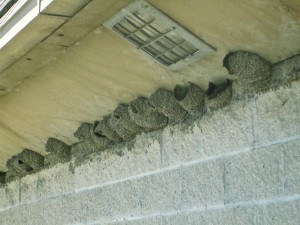In the Mass Audubon class I’m taking, tonight’s lecture was on birds. We learned about a scientific paper titled, “Urban gulls show similar thermographic and behavioral response to human shouting and conspecific alarm cries” (Frontiers in Ecology and Evolution, 20 Sept. 2022). Equipment used in this research included a plush Cornish pasty and a child’s baby carriage with an infrared camera hidden inside it. No, I am not making this up. Apparently some ornithologists manage to have a sense of humor while doing serious science.
Tag: gulls
CSI Seagull
What happened here?
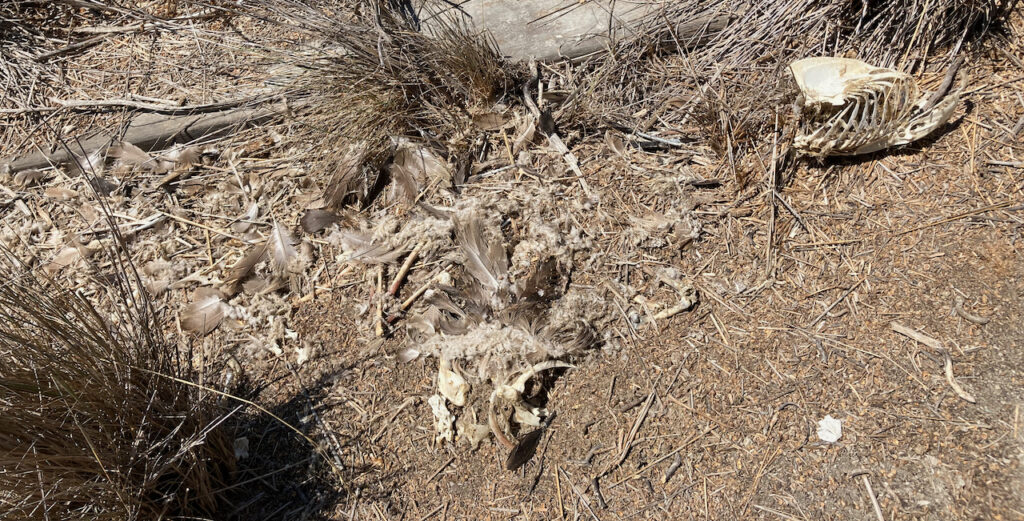
It’s like one of those crime scenes you see in pop culture. Except that instead of human remains, it’s the remains of a bird. I found this on the dike next to Adobe Creek in Palo Alto, right across from the island in the marsh where there’s a California Gull nesting colony. The rib cage in the upper right corner of the photo is big enough to be from a gull — it’s about eight inches long — and check out that huge breast bone for the flight muscles to attach to. The other bones are scattered in the center of the photo, though there appear to be some bones missing. There are lots of feathers — grey feathers characteristic of juvenile gulls.
Before you start mourning the death of a young gull, remember that the mortality rate of young gulls is high. Something on the order of 75% of nestlings die before they develop flight feathers (Patricia Baird, Comparative Ecology of California and Ring-billed Gulls [Larus californicus and L. delawarensis], Ph.D. dissertation, Univ. of Montana, 1976). After the birds learn to fly, but before they move on to winter quarters, mortality rates are on the order of 5%, although in bad years post-fledging mortality rates could be as high as 70% (Kristie N. Nelson, Nora Livingston, and Teague Scott, “Population size and reproductive success of California Gulls at Mono Lake, California,” Point Blue, 2015). In short, perhaps 75-90% of young California Gulls die before they’re six months old. Predators
So it would not be surprising if a juvenile California Gull were killed here. Any number of predators might have killed it — a raptor, a dog off leash, a raccoon, a coyote. But any clues to what the predator was have doubtless been obliterated by the carrion eaters that came along after the predator was finished — Turkey Vultures, American Crows, rats, and other critters must have further scattered the bones and feathers.
About all we can say for certain is that a juvenile gull died here. It died some time after it fledged — California Gull nestlings were fledging beginning about a month and a half ago — but long enough ago that the bones are been picked clean and are now dry and without odor.
Winnemuca, Nev., to Evanston, Wyo.
This morning, I had a hard time getting on the road; a week’s worth of twelve-hour days running Ecojustice Camp finally caught up with me. I was a little bleary when I started driving. Yesterday in a truck stop I had found an audiobook, on CDs no less, of Isaac Asimov’s I, Robot, and I put the first disc into the car’s CD player. When I was in high school, I had loved I, Robot; I found I still liked it, even though there were huge holes in the plot, even though Asimov doesn’t appear to like women very much, even though he mixes slide rules and space ships; I liked it even though the characters were caricatures, but they were engaging caricatures.
At some point after I passed through Battle Mountain, I began to notice how green the mountains looked — green by northeastern Nevada standards, that is. It had obviously rained in the recent past. Then I began to notice the banks of yellow flowers along the edges of the interstate; I could not only see them, but in a few places I could feel the pollen in the air. They ere so stunning in that desert landscape that I finally pulled over at the exit ramp to Welcome, Nevada, and photographed them. They looked bright and dramatic against the freshly green sage brush.
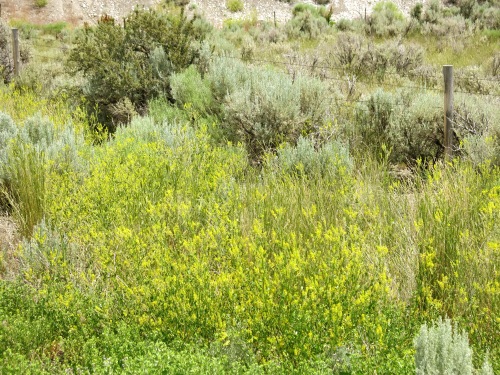
I rolled through dreary little West Wendover, Nevada, its faintly shabby casinos looking even more shabby in that huge landscape, with towering mountains, and the white expanse of the salt flats stretching eastward into the haze. I rolled across the salt flats — stopping briefly to eat a sandwich in the shade of the rest area in the middle of the salt flats — across the plains and hills on the other side, and got off at the Dugway exit. The directions said to head north, take an immediate left, go a third of a mile, then take the right fork. But the road didn’t fork, it terminated in the exit gate of a huge Cargill salt facility, with a railroad siding and towering piles of salt. Finally I figured out that what I was supposed to do was to turn right at the gates to the Cargill plant, and sure enough there I was at the entrance to Timpe Spring Wildlife Management Area.
One moment I was between the railroad siding and the salt plant, and the next moment I was driving along a narrow dirt road looking out at American Avocets and Black-necked Stilts squawking at me, and California Gulls soaring purposefully overhead towards Antelope Island, which loomed out of the invisible Great Salt Lake in the distance, and a Northern Shoveler dabbling at the edge of the marsh with that absurdly long bill it has.
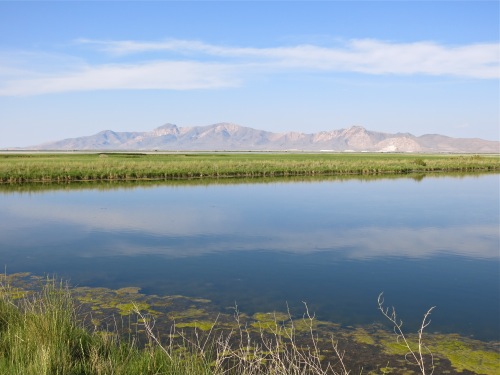
I started walking out across one of the dikes, but Forster’s Terns and Black-necked Stilts began circling closer and closer to me, and Song Sparrows came up out of the brush at the edge of the dike, all of them giving calls of alarm. Obviously, I was getting too close to their nests. So I walked out along the other dike, but soon an American Avocet and a Wilson’s Phalarope came out of the marsh grasses giving their calls of alarm, so I retreated once more. By that time, I had been walking around for most of an hour, and the temperature was one hundred degrees even, and I was longing for a drink of water. I walked back to the car.
The birds were not so bothered by me while I was in the car. I drove out very slowly, stopping several times to see if I could see the nests of the American Avocets and the Black-necked Stilts, but I could not; the nests must have been well down in the marsh grass. I swatted one last biting fly, slow and stupid from the heat, that had landed on my face, rolled up the window, and drove on to Evanston, Wyoming.
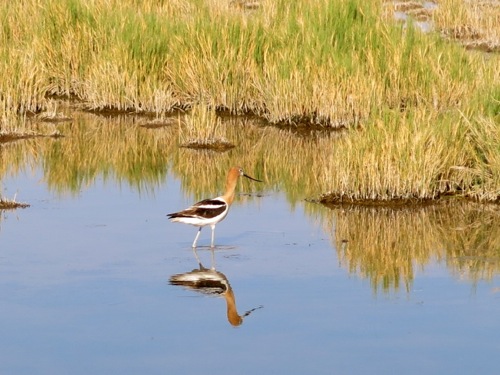
Fast food for gulls
I spent the afternoon and early evening hiking around Pescadero Marsh. At the beach near the end of Pescadero Creek, I saw many of the same animals I saw during my last trip here: Harbor Seals (Phoca vitulina): shells of the California Mussel (Mytilus californianus): the remains of Red Crabs (Cancer productus), Pacific Sand Crabs (Emerita analoga), and Eccentric Sand Dollar (Dendraster exentricus); Black Oystercatchers (Haematopus bachmani), etc.
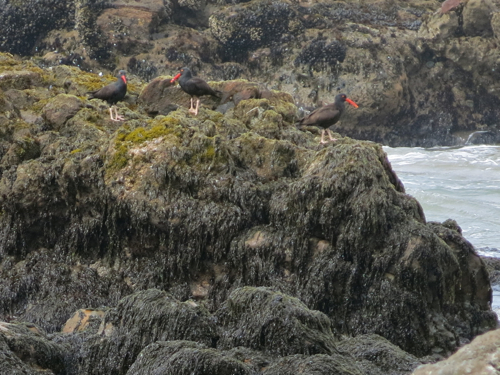
Above: Black Oystercatchers on the rocks at Pescadero Beach
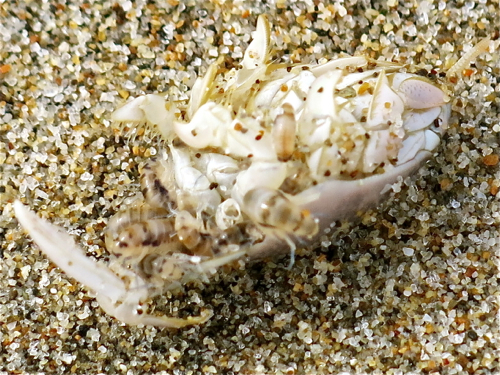
Above: The remains of a Pacific Sand Crab being eaten by unidentified smaller organisms
Walking around the marsh, I saw an even greater diversity of animals: warblers hiding in willow thickets, butterflies cruising in amongst the coastal scrub, raptors hunting over the marsh, huge nests made by wood rats. This is an area of ecotones, where several different plant communities meet one another: ocean comes up against beach; sandy beach comes up against coastal scrub; coastal scrub comes up against saltwater marsh; freshwater riparian corridor and marsh flows into saltwater marsh. I’m amazed by how many biomes, and organisms adapted to live specifically in those biomes, can be found within a short walk: I saw Arroyo Willow (Salix hinsiana) growing next to an ephemeral freshwater stream; fifteen minutes of slow walking brought me to Snowy Plovers (Charadrius alexandrius) who live and breed on sandy beaches above the high tide line.
And then there are the organisms who happily move from one biological community to another, exploiting the resources of all of them. Like gulls (Larus spp.) who fly everywhere, and eat everything. Everywhere I went, I saw gulls. As I walked north on the beach, I cam across two Western Gulls (Larus occidentalis), in beautiful fresh plumage, snacking on what remained of a Harbor Seal:
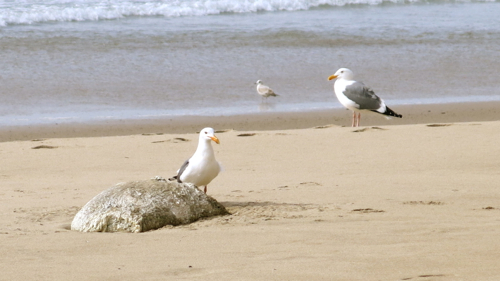
I walked up to the dead Harbor Seal to have a look; the gulls, looking grumpy, gave way to my intrusion, watching me from a safe distance. The corpse didn’t stink, but there was no longer a head, and it looked like it had been lying there for a while. I guess gulls will eat just about anything.
Checklist for week on New England coast
A score of ten or better on this checklist is required for satisfactory completion of week-long stay on New England coast.
Walked along beach and picked up shells — check
Clambered over rocks on a jetty or breakwater — check
Ate fried clams (fresh, tender, and sweet, not the frozen crap you get inland) while sitting on beach — check
Sat in rocking chair on porch and looked at ocean — check
Got too much sun — check
Ate lobster roll (with identifiable claw meat, not that chopped up crap that you get inland) — check
Conversed in eastern New England dialect — check
Took afternoon naps — check
Got drenched in a sudden squall — check
Had weather cool enough to need a jacket, and hot enough to sweat while sitting still — check
Watched guys fishing for stripers and not catching anything — check
Watched seagulls and terns fishing and catching a lot — check
Dinner for gulls
Walking down the beach this afternoon, I paused to watch a Herring Gull flying along with something in its mouth. It landed near me, and dropped a good sized crab on the sand. The crab landed on its legs and started to scuttle away, but after fumbling once, the gull expertly flipped the crab on its back. The crab weakly waved its legs in the air while the gull tilted its head on one side so it could look at the crab with one eye.
I walked over so I could better see the crab. The gull kept an eye on me, and when I got within ten feet of it, it flapped its wings, rose in the air, and settled down twenty feet away, screeching at me. The body of the crab was a good four or five inches across — perhaps a foot across with the legs. With the toe of my shoe, I flipped it over to get a better look. The upper side of the carapace was a reddish-brown color, so it was probably Cancer irroratus or Cancer borealis. The crab plowed its head end into the sand and began to move slowly and feebly along. I walked about twenty feet away, and turned to watch.
When I was a safe distance away, the gull flew back in. Again, it expertly flipped the crab onto its back. Then it stabbed sharply into the crab’s vulnerable underside; the crab’s legs waved feebly; the gull stabbed again; and once more, on this last stab bringing a chunk of flesh up. The crab’s legs twitched a little. The gull flipped its head back and swallowed the piece of flesh, then stabbed again and again. The gull was a messy eater, and little chunks of carapace and flesh and bits of leg got scattered around on the sand. The crab had stopped moving by this point. I left the gull to its dinner, and walked on down the beach.
Nests
At lunchtime, I went for a walk at Baylands Nature Preserve along the Bay in Palo Alto. One of the first things I saw was a baby American Avocet, still with downy plumage, sweeping the water for small invertebrates. American Avocets are a precocial species, so this little baby was pretty much on its own; there were no adult birds nearby.
A little further on I saw a line of Cliff Swallow nests on a building. The swallows pick up some mud in their bills, then fly up and apply it to the nest, gradually building the structure out so as to completely enclose the nesting birds except for small entry holes. The two nests closest to the camera are darker around the entry holes; that’s where mud has been recently applied, and the damp mud is darker than the dried mud.
I kept walking out the dike along Charleston Slough, past other birds that are I guessed were nesting, though I didn’t actually see a nest or babies: Forster’s Terns, Marsh Wrens, a Northern Harrier, Snowy Egrets, Mallards. About a mile and a quarter from the parking lot, I could finally see the California Gull nesting colony. The gulls were screaming and flying in swirling circles above the colony, and as I got closer I could see why: two researchers had kayaked out to the colony, and were walking around with clipboards checking out the nests. The gulls were divebombing them, and through my binoculars, I could see that the researchers were wearing helmets and jackets for protection.
I watched for a while; I like watching gull nesting colonies, and the addition of the invading researchers made it even more entertaining. Then it was time to head back to work, so I walked back to the parking lot, my mind completely emptied of everything except for birds, sun, mud, and nests.

